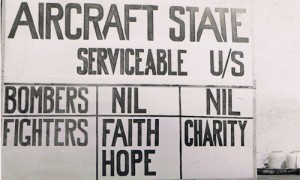“The Maltese had not wanted this war; it had been called down upon their heads. And their almost childlike faith in the ability of the British to defend them, to ultimately prevail against the forces of evil, had been tested to its limits by the gathering hell of the past few months. After two long years of siege, they knew the truth about their predicament.”
Major Ma x Chadwick is the Information Officer for the British army on Malta during World War II. “Loyal Little Malta,” a British colony strategically located between Sicily and North Africa, has been bombarded non-stop by the Germans and Italians for many months. Though British submarines based on Malta have been interrupting German shipping in the Mediterranean since the war began, the British are almost helpless against the Axis air power. In April, 1941, “the Luftwaffe flew a staggering 9600 sorties against the island, almost double the number for March, which itself had shattered all previous records.” The British have three hardy biplanes–Faith, Hope, and Charity–which have been in the air around the clock in an effort to delude the Italians and Germans into thinking they have more planes than they really do. Virtually all their Spitfires and Hurricanes have been destroyed, many while still parked at the airport, and new planes have not arrived. The total number of aircraft available to defend Malta, at this point, is a mere ten, including Faith, Hope, and Charity, while masses of Junker 88s “with a covering fighter force of sixty” attack one or more times a day, bombing the island into rubble.
x Chadwick is the Information Officer for the British army on Malta during World War II. “Loyal Little Malta,” a British colony strategically located between Sicily and North Africa, has been bombarded non-stop by the Germans and Italians for many months. Though British submarines based on Malta have been interrupting German shipping in the Mediterranean since the war began, the British are almost helpless against the Axis air power. In April, 1941, “the Luftwaffe flew a staggering 9600 sorties against the island, almost double the number for March, which itself had shattered all previous records.” The British have three hardy biplanes–Faith, Hope, and Charity–which have been in the air around the clock in an effort to delude the Italians and Germans into thinking they have more planes than they really do. Virtually all their Spitfires and Hurricanes have been destroyed, many while still parked at the airport, and new planes have not arrived. The total number of aircraft available to defend Malta, at this point, is a mere ten, including Faith, Hope, and Charity, while masses of Junker 88s “with a covering fighter force of sixty” attack one or more times a day, bombing the island into rubble.

While Max tries to keep up the wartime morale of the island with his posts, the raids continue, but so does the social life for the British, with dinners, the Malta Amateur Dramatic Club, a bar scene, and, of course, the “sherry queens” who entertain at the bars. When Carmela Cassari, a sherry queen from the Blue Parrot turns up dead, Max’s best friend, Dr. Freddie Lambert, secretly brings Max to the mortuary to see her suspicious wounds–and something else. This time the victim is clutching a torn shoulder tab from a British uniform. Max also learns from Freddie that two other sherry queens have also died recently. They conclude that a serial killer is on the loose, and that this killer is a British officer.
With the never-ending air raids, the constant need to rush to the shelters dug deep into Malta’s rock, the siege and its attendant shortages, and the growing number of civilian deaths, the populace is weary, and some Maltese are wondering aloud whether the British will soon abandon them to their fate. British submarines are about to be relocated away from Malta, and the promised Spitfires have not yet arrived. With all this bad news to deal with, Max is not sure how to deal with the three murders, which so far have not been connected in the public mind to a serial killer. He believes that justice must be done, but fears creating an even worse morale problem on the island. Knowing that his reports to his superiors will be ignored, he decides to investigate on his own, using some of his own contacts for information. Who to trust is a problem, however, since someone on the island with high-level knowledge (perhaps a British officer) is funneling strategic information to the Germans.
A uthor Mark Mills creates an atmospheric and ambitious novel of Malta, which, during World War II, was “the most bombed place on earth,” and he attempts a wide scope in less than three hundred pages. Unfortunately, this allows him little opportunity for full development of any of his plot lines. Though the novel takes place during a horrendous period of carpet bombing, it is not a war novel in the traditional sense, as the strategizing and maneuvering which one sees in most war novels are not significant here. How the Maltese survived, and the inbred traits which kept driving them would have been a vibrant topic for discussion and illustration in this novel, but nearly all the important characters here are British (with one American), the Maltese remaining on the periphery. A section which appears at the end of each chapter takes us into the mind of the killer of the sherry queens, suggesting a psychological emphasis, but the killer’s personality does not jell, and the reader does not get a sense of his compulsion to kill and why. When the killer’s identity is learned, it comes as a surprise, rather than from a growing awareness of clues. The three women who are killed and details of their deaths are presented as facts, rather than as stories within stories.
uthor Mark Mills creates an atmospheric and ambitious novel of Malta, which, during World War II, was “the most bombed place on earth,” and he attempts a wide scope in less than three hundred pages. Unfortunately, this allows him little opportunity for full development of any of his plot lines. Though the novel takes place during a horrendous period of carpet bombing, it is not a war novel in the traditional sense, as the strategizing and maneuvering which one sees in most war novels are not significant here. How the Maltese survived, and the inbred traits which kept driving them would have been a vibrant topic for discussion and illustration in this novel, but nearly all the important characters here are British (with one American), the Maltese remaining on the periphery. A section which appears at the end of each chapter takes us into the mind of the killer of the sherry queens, suggesting a psychological emphasis, but the killer’s personality does not jell, and the reader does not get a sense of his compulsion to kill and why. When the killer’s identity is learned, it comes as a surprise, rather than from a growing awareness of clues. The three women who are killed and details of their deaths are presented as facts, rather than as stories within stories.

Still, for those interested in reading an unusual novel about “this little lump of rock in the middle of the Mediterranean” and its amazing survival during the horrors of World War II, this novel opens up many avenues for further exploration. The references to real places and events are numerous (and fun to look up on Google) and a sense of what the island looks like shines through. Several World War II websites devote many pages and dozens of photographs to the Siege of Malta, and through them, I became caught up in Malta’s history. Several wonderful YouTube films bring this history to life. (See Notes) Though the novel has its weaknesses, it still made me want to know more about the island, and the easy internet research satisfied my curiosity.
Notes: The author’s photo appears on his Harper Collins Author Page.
The listing of available planes at the air field in Malta in 1940 shows Faith and Hope, the biplanes, still serviceable. The next photo shows the destruction of Hope. http://www.killifish.force9.co.uk
A rare color film shows the Battle for Malta. Wait for the voice on this one, as the video provides much information.
